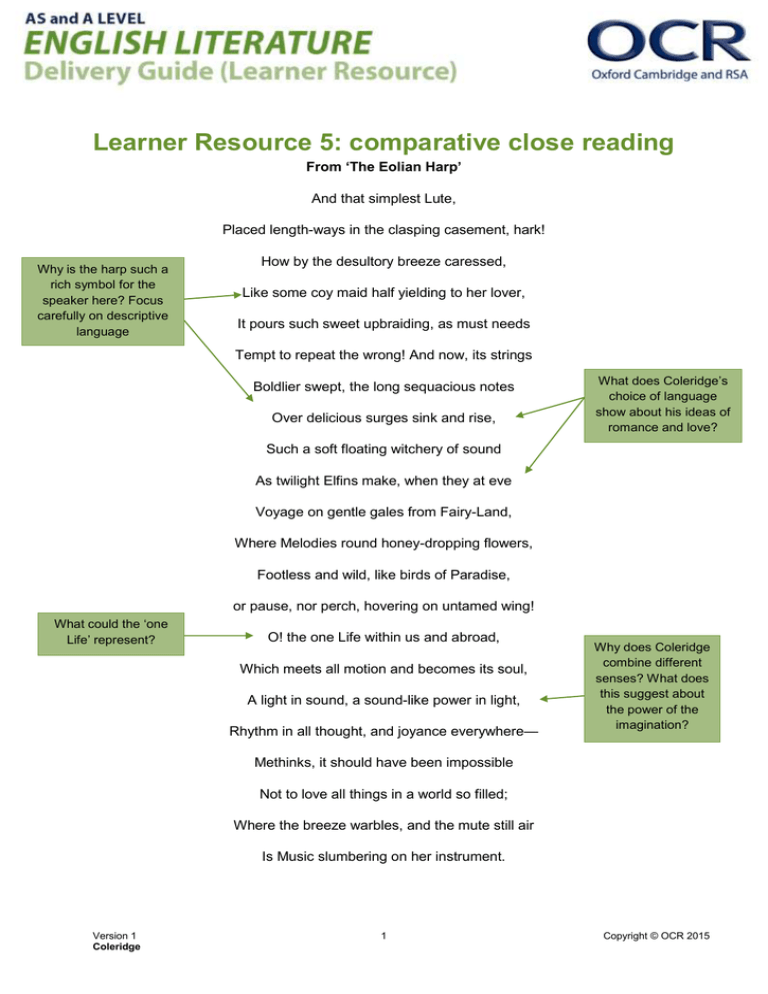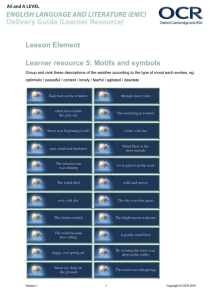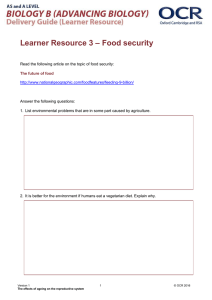Learner Resource 5: comparative close reading
advertisement

Learner Resource 5: comparative close reading From ‘The Eolian Harp’ And that simplest Lute, Placed length-ways in the clasping casement, hark! Why is the harp such a rich symbol for the speaker here? Focus carefully on descriptive language How by the desultory breeze caressed, Like some coy maid half yielding to her lover, It pours such sweet upbraiding, as must needs Tempt to repeat the wrong! And now, its strings Boldlier swept, the long sequacious notes Over delicious surges sink and rise, What does Coleridge’s choice of language show about his ideas of romance and love? Such a soft floating witchery of sound As twilight Elfins make, when they at eve Voyage on gentle gales from Fairy-Land, Where Melodies round honey-dropping flowers, Footless and wild, like birds of Paradise, or pause, nor perch, hovering on untamed wing! What could the ‘one Life’ represent? O! the one Life within us and abroad, Which meets all motion and becomes its soul, A light in sound, a sound-like power in light, Rhythm in all thought, and joyance everywhere— Why does Coleridge combine different senses? What does this suggest about the power of the imagination? Methinks, it should have been impossible Not to love all things in a world so filled; Where the breeze warbles, and the mute still air Is Music slumbering on her instrument. Version 1 Coleridge 1 Copyright © OCR 2015 And thus, my Love! as on the midway slope Of yonder hill I stretch my limbs at noon, Whilst through my half-closed eyelids I behold Why is ‘tranquillity’ so important for the poet? The sunbeams dance, like diamonds, on the main, And tranquil muse upon tranquility: Full many a thought uncalled and undetained, And many idle flitting phantasies, Traverse my indolent and passive brain, As wild and various as the random gales How does Coleridge build up the relationship between the harp metaphor and the poetic imagination? That swell and flutter on this subject Lute! And what if all of animated nature What does this verse paragraph show about the relationship between nature and the imagination? Be but organic Harps diversely framed, That tremble into thought, as o’er them sweeps Plastic and vast, one intellectual breeze, At once the Soul of each, and God of all? Version 1 Coleridge 2 Copyright © OCR 2015 From ‘Dejection: an Ode’ I Well! If the Bard was weather-wise, who made The grand old ballad of Sir Patrick Spence, This night, so tranquil now, will not go hence Unroused by winds, that ply a busier trade How does the presentation of tranquillity in this poem differ from ‘The Eolian Harp’? Than those which mould yon cloud in lazy flakes, What is the poet suggesting about the power of the stormy winds? How does it compare to the power of the poetic imagination? Or the dull sobbing draft, that moans and rakes Upon the strings of this Æolian lute, Which better far were mute. For lo! the New-moon winter-bright! And overspread with phantom light, (With swimming phantom light o'erspread But rimmed and circled by a silver thread) How does the light imagery here differ from ‘The Eolian Harp’? What relationship does it have with creation and destruction? I see the old Moon in her lap, foretelling The coming-on of rain and squally blast. And oh! that even now the gust were swelling, And the slant night-shower driving loud and fast! Those sounds which oft have raised me, whilst they awed, And sent my soul abroad, Might now perhaps their wonted impulse give, Might startle this dull pain, and make it move and live! Version 1 Coleridge 3 How does the speaker compare present feelings about nature to the past? Copyright © OCR 2015 II A grief without a pang, void, dark, and drear, How does Coleridge show the speaker’s feelings of dejection? Focus on language, repetition and rhyme. A stifled, drowsy, unimpassioned grief, Which finds no natural outlet, no relief, In word, or sigh, or tear— O Lady! in this wan and heartless mood, To other thoughts by yonder throstle woo'd, All this long eve, so balmy and serene, Have I been gazing on the western sky, And its peculiar tint of yellow green: What effect does passivity within the poet’s mind have in this poem? How does this contrast with the role of passivity in ‘The Eolian Harp’? And still I gaze—and with how blank an eye! And those thin clouds above, in flakes and bars, That give away their motion to the stars; Those stars, that glide behind them or between, Now sparkling, now bedimmed, but always seen: Yon crescent Moon, as fixed as if it grew In its own cloudless, starless lake of blue; I see them all so excellently fair, Why does the speaker repeat that he can ‘see’ everything within the natural landscape? How does this compare with feelings towards the landscape in ‘The Eolian Harp’? I see, not feel, how beautiful they are! OCR Resources: the small print OCR’s resources are provided to support the teaching of OCR specifications, but in no way constitute an endorsed teaching method that is required by the Board, and the decision to use them lies with the individual teacher. Whilst every effort is made to ensure the accuracy of the content, OCR cannot be held responsible for any errors or omissions within these resources. © OCR 2015 - This resource may be freely copied and distributed, as long as the OCR logo and this message remain intact and OCR is acknowledged as the originator of this work. OCR acknowledges the use of the following content: Please get in touch if you want to discuss the accessibility of resources we offer to support delivery of our qualifications: resources.feedback@ocr.org.uk Version 1 Coleridge 4 Copyright © OCR 2015 Version 1 Coleridge 5 Copyright © OCR 2015


